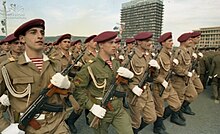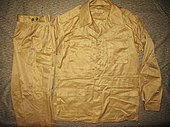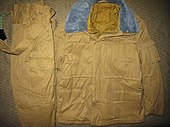Afghanka
This article has multiple issues. Please help improve it or discuss these issues on the talk page. (Learn how and when to remove these template messages)
|
| M88 "Afghanka" | |
|---|---|
Two types of Afghanka uniforms. The summer version (Left) and the winter version (Right). | |
| Type | Military uniform |
| Place of origin | Soviet Union |
| Service history | |
| In service | 1980s–present |
| Used by | See Users |
| Wars | Soviet–Afghan War First Chechen War |
| Production history | |
| Variants | See Variants |
The Afghanka (Russian: Афганка, romanized: Afganka; proper designation: M88) is a type of military uniform system developed and issued by the Soviet Army in the early 1980s, still in use today in some post-Soviet states in many different variants. The name Afghanka is an unofficial popular slang term in Russian for the uniform, derived from its prolific use during the Soviet–Afghan War. Only sand coloured versions of the M88 are called Afghanka.
They are typically made of cotton (Russian: хлопчатая бумага or "Х/б", "cotton paper").
Design details
The Afghanka field uniform is made in a lightweight summer and heavier, lined winter version; both consist of a long, loose fitting 6-pocket

The winter model is composed of: jacket, jacket liner, trousers, plus insulated liners and suspenders. The liners are buttoned into their respective garments, and the outer garment can be worn without the liners. The jacket liner bears the fur collar of the jacket, usually in fish fur but occasionally in real fur (officer's uniforms). The jacket and trousers are lined with a pile-type material that helps insulate by trapping warm air, whereas the liners are made of a quilted material similar to the Telogreika uniform.
Colouring

Both uniforms were originally made in a

Since the fall of the Soviet Union, the Afghanka has been copied and issued widely by CIS members in various localized camouflage patterns.
Operational history

The Afghanka began appearing in military units in the early 1980s during the
The soldiers found the new uniform to be very effective, especially in
Variants
The Afghanka was initially issued to regular units of the armed forces in a khaki colour. The uniform was also standardized with the
Although derived from a previous chemical-warfare uniform known as OKZK-D, the camouflage uniform made for

The Soviet and
Users
Former users

 Armenia[citation needed]
Armenia[citation needed] Azerbaijan[citation needed]
Azerbaijan[citation needed] Belarus
Belarus Kazakhstan
Kazakhstan Kyrgyzstan
Kyrgyzstan Russia
Russia Soviet Union
Soviet Union Turkmenistan[citation needed]
Turkmenistan[citation needed] better source needed]
better source needed] better source needed]
better source needed] better source needed]
better source needed]
See also
- Panamanka
- Kepka-afganka
- Valenki
- Podvorotnichok
- Battle Dress Uniform
Notes
- ISBN 0-7643-0462-3[page needed]
- ^ "National Archives NextGen Catalog". catalog.archives.gov. Retrieved 2023-03-25.
- ^ @trip_to_valkiri (March 8, 2024). "Use of Soviet "Afghanka" style uniforms by Ukrainian Armed Forces, 2000s period" (Tweet) – via Twitter.
- ^ "imgur.com". Imgur. Retrieved 14 January 2024.
- ^ "General Shahnawaz Tanai - په لویه پکتیا کی ستر جګړه ایز عملیات! په ۱۳۵۷ هجری کال کې د انقلاب مخالفینو د مولوي جلال الدین حقاني ترمشرۍ د ګردیز او خوست ترمنځ لویه لاره (۹)کاله بنده کړې وه او هغه ځای ته اکمالات د هوا له لارې کیدل. موږ لمړی ځل په ۱۳۶۴ بیا په ۱۳۶۵ او وروسته په ۱۳۶۶ هجري کالونو کی د کابل ګردیز, نری کوتل او سټې کنډو له لارې دری وارې خوست ته اکمالات وکړل. دولتی پوځونو د لویو لارو په اوږدو کې د ژاوره، مغلګی او مستربل په ډیرو پیچلو جغرافیائي او جنګي ځایونو کې ستر جګړه ایز بریالي عملیات ترسره کړل . د عملیاتو په پای کی دولتي قوتونو ته د بریالیتوبونو په ویاړ قهرماني پوځي رتبې مډالونه اونشانونه ورکړی شول. | Facebook". www.facebook.com. Retrieved 2023-06-21.
Sources
- Soviet Uniforms and Militaria 1917–1991 by ISBN 978-1847972606
- Inside the Soviet Army Today. Osprey Elite Military History Series No. 12 by Stephen J Zaloga
- Russia's War in Afghanistan by David Isby
- Warsaw Pact Ground Forces by David Rottmman
External links
 Media related to Afghanka at Wikimedia Commons
Media related to Afghanka at Wikimedia Commons


